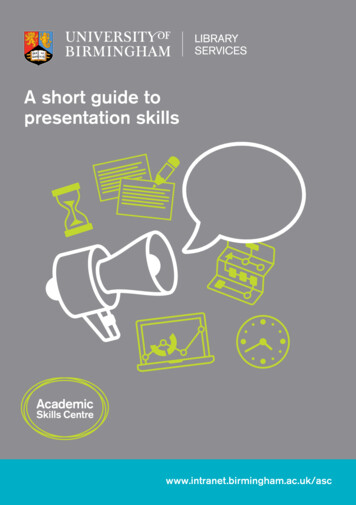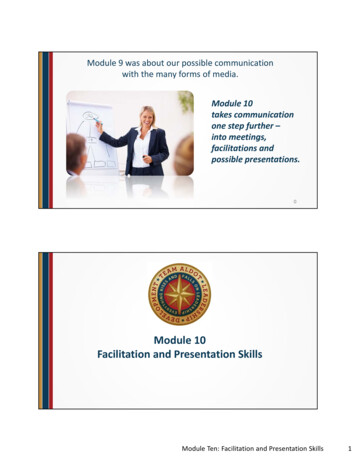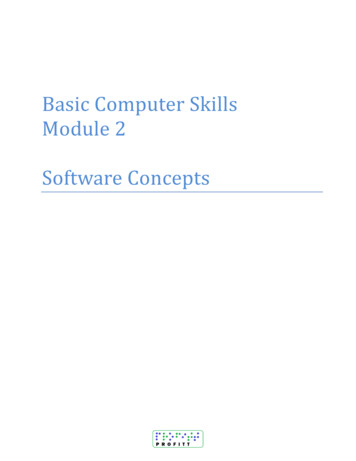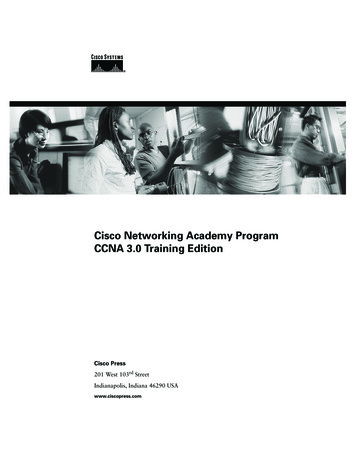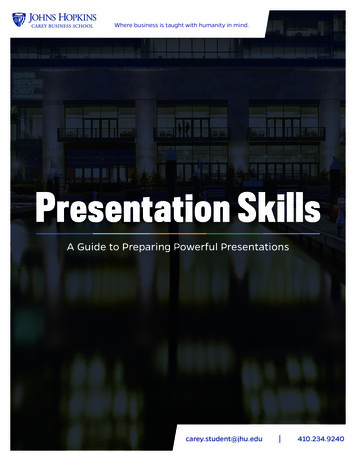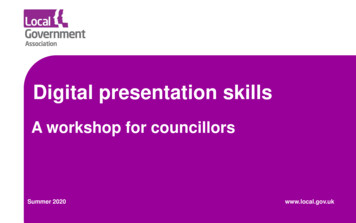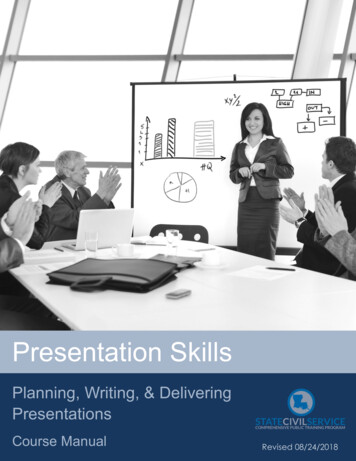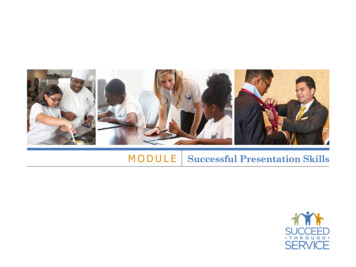
Transcription
MODULESuccessful Presentation Skills
MODULESuccessfu l Pre se nt at i on Sk i l l sMODULE GUIDEWe have developed a Module Guide to assist you with delivering Successful PresentationSkills. It is intended as a guide only and can be adapted to best meet the needs of thestudents. The overarching objective of the presentation is to INSPIRE the students to dotheir best!ENDURING UNDERSTANDINGPresentation skills impact one’s abilityto successfully communicate with others.LEARNING OUTCOMESAt the end of this module, students willbe able to do the following: Avoid committing the top five mistakesmade by presenters. Overcome presentation anxiety. A pply the six presentation deliverybasics.The Module Guide begins with the Enduring Understanding and Learning Outcomes.The Guide contains a Module Overview, which may be used to plan the delivery ofthe segments. The segments, which are mini-lessons, allow the classroom teacherand facilitator(s) to collaborate for effective grouping of segments into a flexible timeframe. The short segments also enable choice among facilitators, as they may selectwhich topic/segment they would like to cover. Some of the longer or more complexsegments include a specific Enhancement(s) or Follow-up Idea(s). These optionalideas may be utilized by either the facilitator(s) or by a classroom teacher, who may beinterested in extending the module.Resources to Enrich and Extend the module are provided in the Succeed ThroughService Resource Guide to help facilitators and the classroom teacher further expandthe segments in the module. These resources are aligned with the Universal Design forLearning (UDL). The Succeed Through Service Resource Guide also provides additionalinformation including links to the Common Core Standards.Remember to incorporate FUN into the module. Consider using music, additional visuals,personal stories and examples, and/or some of the additional resources to bring thepresentation alive! 61
Succeed Through Service TO O L K I TM ODULE OVERVIE WWelcome and PurposeThis Module is designed to introducethe students to Successful PresentationSkills by educating the students on howto overcome anxiety and practicing thedelivery basics (eye contact, facialexpressions, gestures, movement,appearance and voice). Part of the seriesof Succeed Through Service presentations,Successful Presentation Skills consistsof 11 segments captured under fourcategories.1. Welcome to Successful PresentationSkills2. Overview of today’s sessionPresentation Pitfalls3. Top five presenter’s mistakes4. Overcoming anxietyPresentation Pointers5. Delivery basics6. Eye contact and facial expression7. Movement and gestures8. Appearance9. VoiceRecap and Post-Test/Application10. Recap11. Practice/post-testTIME: 1 hour (can be adapted to meet the classschedule). Note: There is enoughcontent in Module Guide to build atwo-hour session, if needed).LOCATION: On-property or in theclassroomEQUIPMENT: Laptop, LCD projector,document, camera/overhead, and screen.MATERIALS: A summary of thesession (example attached), one copyper student; sticky notes; laptop;LCDprojector; document camera/overheadprojector; chart paper and markers.FACILITATORS: Succeed ThroughService Team, made up of employeesfrom a selection of departments. Thesuggested Script(s) and Segues withtheir italicized words are provided asa guide.OVERVIEW: This module is designedto actively involve the attendees indeveloping the knowledge, skills andabilities crucial to achieving theEnduring Understanding anddemonstrating the outcomes listed tothe left. 62
MODULE 3 Successful Presentation SkillsW EL C O M E AND P UR P O S ETopic/TimingSEGMENT 1:Welcome toSuccessfulPresentationSkillsTIME: 5 minutesScripting/DirectionResourcesACTIVITIES:1. Teacher introduces the facilitators to the class.2. Brief introductions by the facilitators (names, positions and briefcareer paths), but only if this is the first time they have met the class.Depending on the size of the class and space available, the icebreakercan be done in one group or smaller groups.Icebreaker Script:“I would like to find out something about each of you. Take a minute andwrite down one thing about yourself that you think is interesting and putyour name at the top.”Collect the papers so the Facilitators can review later.SEGUE: Thank you, I’m looking forward to reading what you’ve writtenabout yourself. Let’s find out about what we’ll be covering today.SEGMENT 2:Overview ofToday’s SessionTIME: 2 minutesACTIVITY/SCRIPT: During the next hour, the Successful PresentationSkills module will provide you with the necessary knowledge and skillsto help you understand how to:1. Avoid committing the top five mistakes made by presenters.2. Overcome presentation anxiety.3. Apply the six presentation delivery basics.SEGUE: Let’s start by discussing the top five mistakes made. 63
Succeed Through Service TO O L K I TP RE S ENTATION P IT F ALL STopic/TimingSEGMENT 3: TopFive Presenter’sMistakesTIME: 7 : Pre-assess through Turn and Talk to the personnext to you): What would you say are the most common mistakes peoplemake when giving presentations? (Solicit responses and recognizeparticipants. Write the answers on the black/whiteboard or flip chart).1. Great job everyone! Here are the top five common mistakes: No presentation goals or objectives Poor delivery techniques Poor first impression No preparation Lack of enthusiasm2. Some other common mistakes could be: No audience involvement Lack of facial expressions Sticky floor syndrome (staying stuck to one spot)By being aware of the above, we can ensure that we don’t fall intothe trap of those common pitfalls or mistakes.ENHANCEMENTLocate a video or a lecture that exemplifies these mistakesand have students critique the presenter, noting all of themistakes that contribute to the poor presentation.SEGUE: Do you feel your legs will never stop shaking while standingup to speak? If you are thinking yes, then you have to manageyour anxiety to become effective presenters. Let’s review sometechniques on how to overcome anxiety. 64
MODULE 3 Successful Presentation SkillsSEGMENT 4:OvercomingAnxietyACTIVITY/SCRIPT: Everyone, even experienced presenters, have someanxiety when presenting in front of a group of people. This is perfectlynormal. The best way to deal with this anxiety is to first acknowledgethat this fear is perfectly normal and that you are not alone.TIME: 8 minutesHow do you think you can overcome this fear or anxiety? (Solicitresponses and recognize participants. Write the answers on the black/whiteboard or flip chart).First and foremost you need to make sure you properly and thoroughlyprepare yourself before you speak. Remember, Fail to Plan Plan to Fail!Factoid: Did You Know? The fear of presenting in public is the number one fear of mostpeople? Over 41% of people have some fear or anxiety dealing withpresenting in front of groups? People who have this fear can experience all kinds of symptomssweaty palms, accelerated heart rate, memory loss and evendifficulty in breathing. Proper preparation and rehearsal can help to reduce this fear byat least 75%.I would like to introduce you to five steps you can take to overcomeyour anxiety:1. Visual-slide: S tep 1: Know your material – If you are not familiar with yourmaterial or are uncomfortable with it, your nervousness willincrease. Practice your speech or presentation and revise ituntil you can present it with ease. 65
Succeed Through ServiceSEGMENT 4:OvercomingAnxietycont . TO O L K I T Step 2: Learn how to relax – You can ease tension by doingexercises. Sit comfortable with your back straight. Breathe in slowly, hold your breath for 4 to 5 seconds, and then slowly exhale.To relax your facial muscles, open your mouth and eyes wide,and then close them tightly. Step 3: Visualize yourself speaking – Imagine yourself walkingconfidently to the stage as the audience applauds. Imagineyourself speaking, your voice loud, clear and assured. When youvisualize yourself as successful, you will be successful. Step 4: Concentrate on your message, not yourself – Yournervous feelings will dissipate if you focus your attention awayfrom your anxieties and concentrate on your message and youraudience, not yourself. Step 5: Turn nervousness into positive energy – The same nervousenergy that causes stage fright can be an asset to you. Harness it,and transform it into vitality and enthusiasm.ENHANCEMENT1. Pair up students.2. Give each pair a page that contains at least three shortpieces (5-8 lines) of high-interest text.3. Ask the students to practice the five steps for about five minutes.4. Have each student in the pair stand and present to his/her partner whileyou circulate.SEGUE: Now that we know how to control anxiety, let’s review someeffective delivery basics. 66
MODULE 3 Successful Presentation SkillsP RE S ENTATION P OINTER STopic/TimingSEGMENT 5:Delivery BasicsTIME: 10 : When you present, you communicate verballyand nonverbally. Like any type of communication, the presentationrequires a message, a message sender and a message receiver. Yourrole in the communication may change: sometimes you will be the sender,sometimes you will be the receiver and sometimes you will be both.1. Brainstorm: In what ways do we communicate nonverbally? (Solicitresponses and recognize participants. Write the answers on the black/whiteboard or flip chart).2. Visual-slide: Eye Contact Facial Expressions Movement Gestures Appearance Voice3. Practice: Divide the participants into 6 small teams and assign one of thesesix delivery basics for each group. In your group, you have 5 minutes to:- Define the delivery basic- Tell how to make it effective. Ask one student from each team to share the teams’ findings. 67
Succeed Through ServiceSEGMENT 6:Eye Contact andFacial ExpressionTIME: 5 minutes TO O L K I TACTIVITY/SCRIPT: People speak with their eyes as well as their words.Eye contact and facial expression are an emotional handshake. One ofthe best ways to make your audience feel a part of the presentation isthrough effective eye contact. By doing that, you will get their undividedattention and keep them interested.1. Practice: A sk the students to establish and maintain eye contact with eachother for few seconds. Ask: How did you feel?2. Visual-slide:Be careful not to hold eye contact too long or the audience membermay feel intimidated by your stare.In addition, be careful not to have “roller coaster eyes,” which are dartingglances to audience members all around the room.Use eye contact to check understanding.When it comes to facial expression, smile and let your face reflect whatyou are saying. Don’t force phony expressions. Relax your facialmuscles through laughter and smiling!ENHANCEMENT1. Pair up students.2. Give each pair a page that contains at least three shortpieces (5-8 lines) of high-interest text. If you used theEnhancement from Segment 4, ask students to apply the new learningsto the same piece of text.3. Ask the students to practice the five steps for about five minutes.4. Have each student in the pair stand and present to his/her partner whileyou circulate. 68
MODULE 3 Successful Presentation SkillsSEGMENT 6:Eye Contact andFacial Expression2. Practice: Ask the students to practice facial expressions whilechatting with each other.cont .SEGUE: Now that we know the importance of eye contact and facialexpression, let’s review movement.SEGMENT 7:Movement andGesturesACTIVITY/SCRIPT:TIME: 5 minutes1. Brainstorm/Visual-slide: What are some movements to avoid as apresenter? (Solicit responses and recognize participants. Write theanswers on the black/ white board or flip chart). Rocking/swaying Podium freeze Nervous movement Hands in pockets2. Visual-slide: A speaker should establish three positions in the room towhich he/she travels throughout the presentation. Home position: This position is where you spend most of your timeduring the presentation. Across from the home position, on the same side of the room: Thisposition is designed to create a change of pace and increase interest in your presentation. The third position is designed for special points in your presentation,and it should be used sparingly: This position is the only one thatcrosses the imaginary line between you and the audience.3. Visual-slide: What about gestures? Make gestures purposeful and natural Use gestures to stress, demonstrate, or complement what you say Use expansive gestures above the waist Keep your elbows away from your bodyAsk the students to practice the above techniques while telling the plotof a favorite movie or book. 69
Succeed Through ServiceSEGMENT 7:Movement andGesturescont . TO O L K I TENHANCEMENT1. Pair up students.2. Give each pair a page that contains at least three shortpieces (5-8 lines) of high-interest text. If you used the Enhancement from Segment 4 and 6, ask students to apply the newlearnings to the same piece of text.3. Ask the students to practice the five steps for about five minutes.4. Have each student in the pair stand and present to his/her partnerwhile you circulate.SEGUE: Let’s discuss appearance.SEGMENT 8:AppearanceTIME: 2 minutesACTIVITY/SCRIPT: Appearance is a major factor in creating a firstimpression. Your audience can not help but notice your clothing,grooming and posture.1. Quickwrite: Take one minute to respond on a sticky note to thefollowing question: How can you enhance your credibility through your appearance?(Solicit responses and recognize participants. Write the answers onthe black/white board or flip chart).2. Brainstorm: What grooming tips should we consider whenpresenting? (Solicit responses and recognize participants. Write theanswers on the black/white board or flip chart). 70
MODULE 3 Successful Presentation SkillsSEGMENT 8:Appearancecont .4. Visual-slide: Your dress should communicate a professional image Posture: stand up straight, but not stiff Attitude: The only attitude that is appropriate for a presentation is anupbeat positive one! No audience wants to listen to an unenthusiastic,disinterested speaker.SEGUE: The last communication delivery basic is voice.SEGMENT 9:VoiceTIME: 4 minutesACTIVITY/SCRIPT: What are some things to consider to effectivelyuse your voice? (Solicit responses and recognize participants. Writethe answers on the black/white board or flip chart). Visual-slide: Projection: Make sure you speak loud enough for the audience tohear you Pitch: Don’t speak in a monotone voice Pace: Alternate the pace of your voice Slow down for important points Diction: Speak more clearly than normal Get rid of the “Ums” and “Uhs” 71
Succeed Through Service SEGMENT 9:Voicecont .TO O L K I TENHANCEMENT1. Pair up students.2. Give each pair a page that contains at least three shortpieces (5-8 lines) of high-interest text. If you used the Enhancement from Segments 4, 6 and 7, ask students to apply the newlearnings to the same piece of text.3. Ask the students to practice the five steps for about five minutes.4. Have each student in the pair stand and present to his/her partner.SEGUE: Let’s recap what we’ve covered!RE C A P AND P O S T - A S S E S S M ENT /A P P LI C ATIONTopic/TimingSEGMENT 10:RECAP ANDREHEARSETIME: 7 : Let’s go over the steps we covered today to ensureyou will be able to make a successful presentation. Provide the recap inthe form of a handout. Sample is attached. Visual-slide:The 5 Steps toOvercome Your Anxiety1. Know your materials2. Learn how to relax3. Visualize yourself speaking4. Concentrate on your message5. T urn nervousness into positiveenergyThe 6 Delivery Basics:1. Eye Contact2. Facial Expressions3. Movement4. Gestures5. Appearance6. Voice 72
MODULE 3 Successful Presentation SkillsSEGMENT 10:RECAP ANDREHEARSEGive students the opportunity to apply the Steps and Basics as theyrehearse independently and/or with a partner. See Enhancement belowfor a source of content for their presentations.cont .ENHANCEMENT1. Pair up students.2. Give each pair a page that contains at least three shortpieces (5-8 lines) of high-interest text. If you used the Enhancement from Segments 4, 6 and 7, ask students to apply the newlearnings to the same piece of text.3. Ask the students to practice the five steps for about five minutes.4. Have each student in the pair stand and present to his/her partner whileyou circulate.SEGUE: Let’s now practice what we’ve learned today!SEGMENT 11:PRACTICEPOST ASSESSMENTTIME: 10 minutesACTIVITY/SCRIPT: Remember:I hear and I forget, I see and I remember, I do and I understand!So it is time to practice what we learned today through your presentations!Are you ready? ption 1: Volunteers Present Ask for volunteers to present (using theOabove techniques), applying the three learning outcomes from today’ssession. OROption 2: DLIQ Survey (immediately follows Segment 11)Provide recognition and feedback. Fond farewell. 73
Succeed Through ServiceMODULE TO O L K I THow to D e l i ve r a S u cce ssf u l Pre se ntatio nHANDOUTThe Five Steps to Overcome Your Anxiety1. Know your materials2. Learn how to relax3. Visualize yourself speaking4. Concentrate on your message5. Turn nervousness into positive energyThe Six Delivery Basics1. Eye contact2. Facial expressions3. Movement4. Gestures5. Appearance6. Voice 74
MODULE 3 Successful Presentation SkillsMODULESuccessful Presentation Skills S U R V E YDid? What did you do during this presentation?Learn? What did you learn during this presentation?Interesting? What did you find interesting during this presentation?Questions? What questions do you have about something in this presentation? 75
The Ritz-Carlton Hotel Company, LLC 4445 Willard Avenue Suite 800 Chevy Chase, MD 20815 www.ritzcarlton.com
MODULE Successful Presentation Skills MODULE GUIDE We have developed a Module Guide to assist you with delivering Successful Presentation Skills.It is intended as a guide only and can be adapted to best meet the needs of the students. The overarching objective of the presentat

